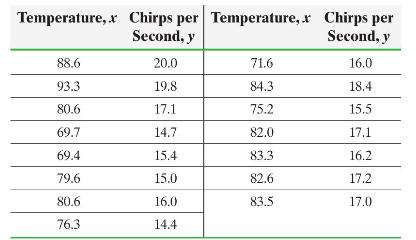Crickets make a chirping noise by sliding their wings rapidly over each other. Perhaps you have noticed
Question:
Crickets make a chirping noise by sliding their wings rapidly over each other. Perhaps you have noticed that the number of chirps seems to increase with the temperature. The following table lists the temperature (in degrees Fahrenheit, \({ }^{\circ} \mathrm{F}\) ) and the number of chirps per second for the striped ground cricket.

(a) What are the estimates of \(\beta_{0}\) and \(\beta_{1}\) ? What is the mean number of chirps when the temperature is \(80.2^{\circ} \mathrm{F}\) ?
(b) Compute the standard error of the estimate, \(s_{e}\).
(c) Determine whether the residuals are normally distributed.
(d) Determine \(s_{b}\).
(e) If the residuals are normally distributed, test whether a linear relation exists between the explanatory variable, \(x\), and response variable, \(y\), at the \(\alpha=0.05\) level of significance.
(f) If the residuals are normally distributed, construct a \(95 \%\) confidence interval for the slope of the true leastsquares regression line.
(g) Construct a 90\% confidence interval for the mean number of chirps found in part (a).
(h) Predict the number of chirps on a day when the temperature is \(80.2^{\circ} \mathrm{F}\).
(i) Construct a 90% prediction interval for the number of chirps found in part (h).
(j) Explain why the predicted number of chirps found in parts (a) and (h) are the same, yet the intervals are different.
Step by Step Answer:

Statistics Informed Decisions Using Data
ISBN: 9781292157115
5th Global Edition
Authors: Michael Sullivan





